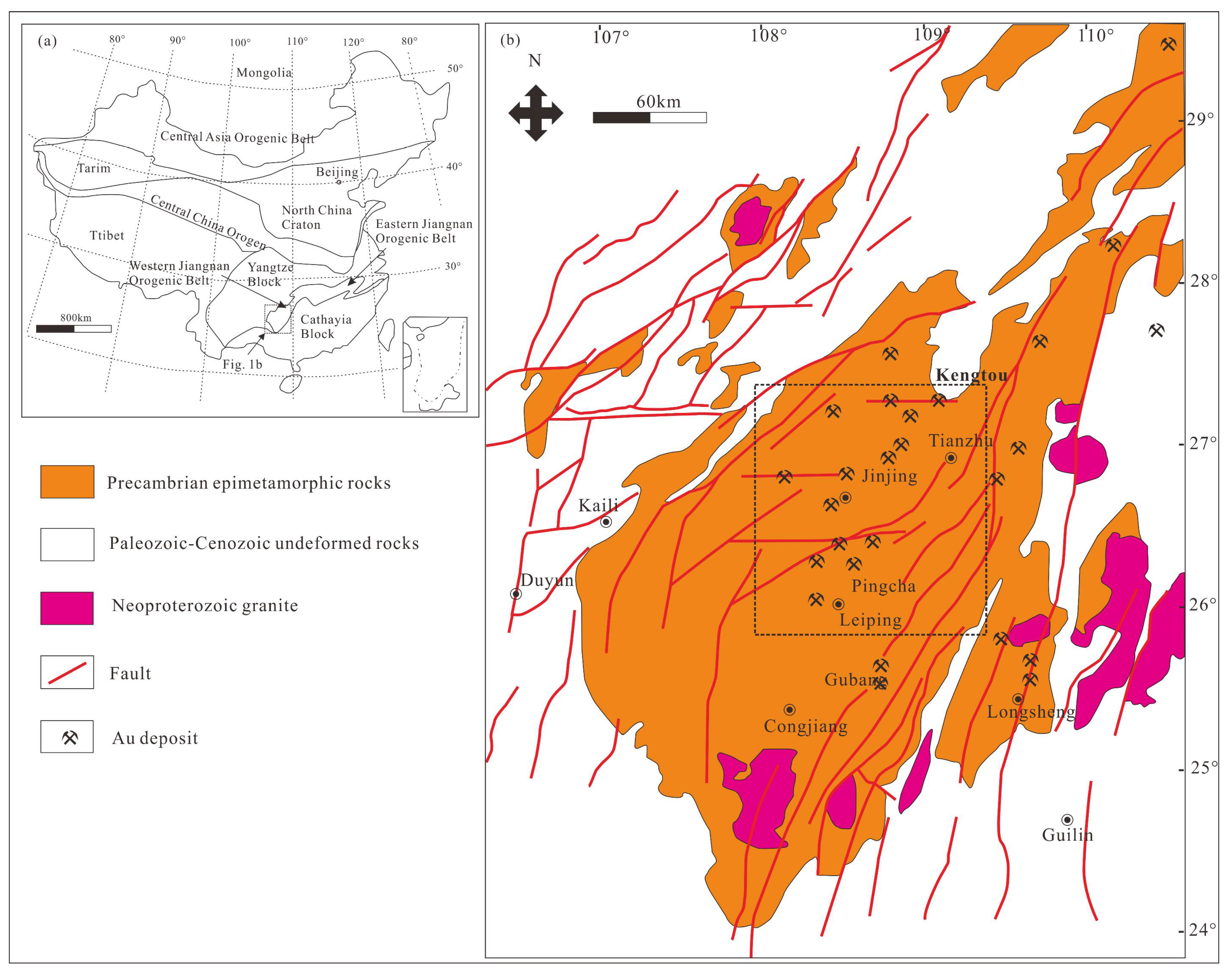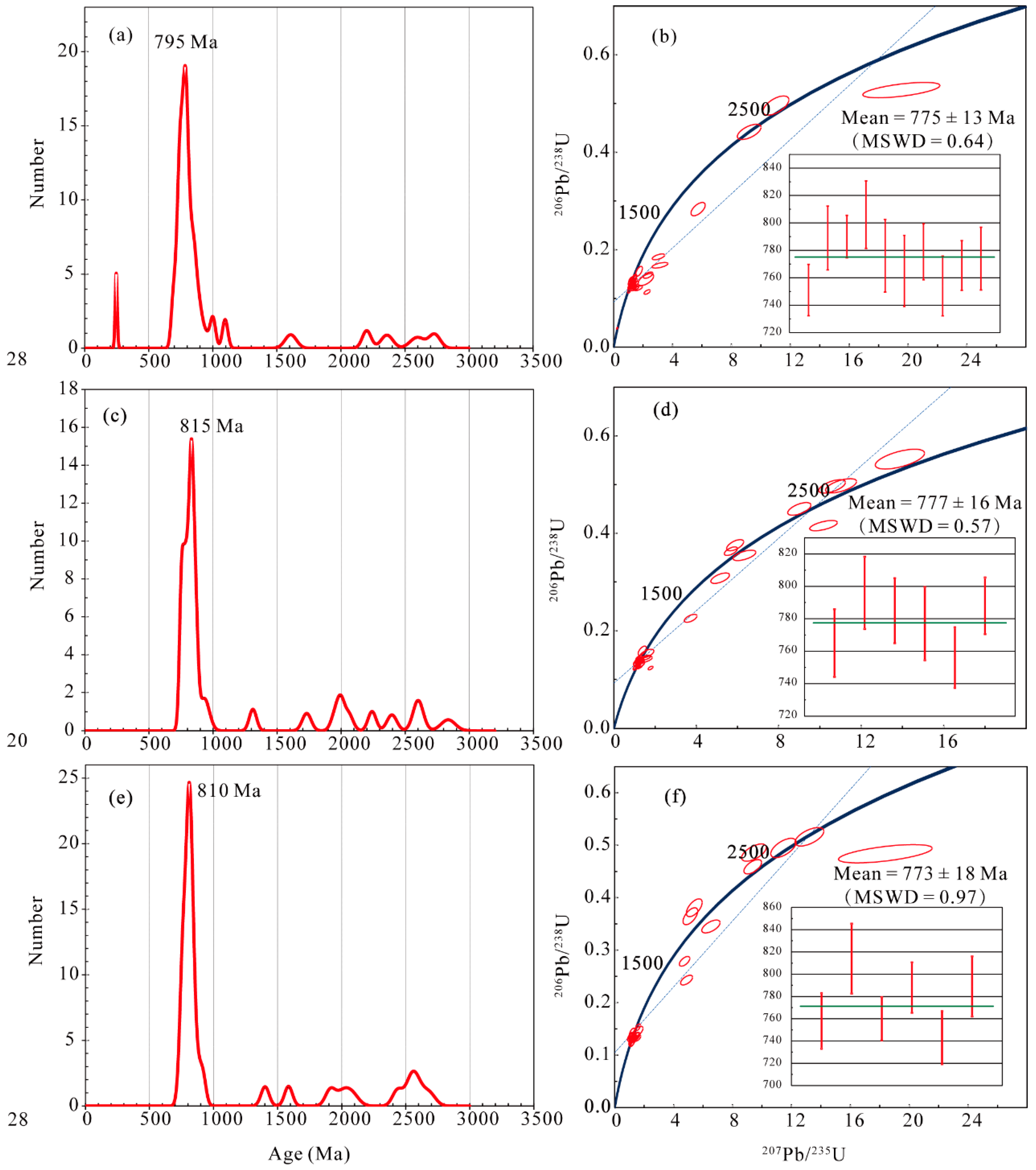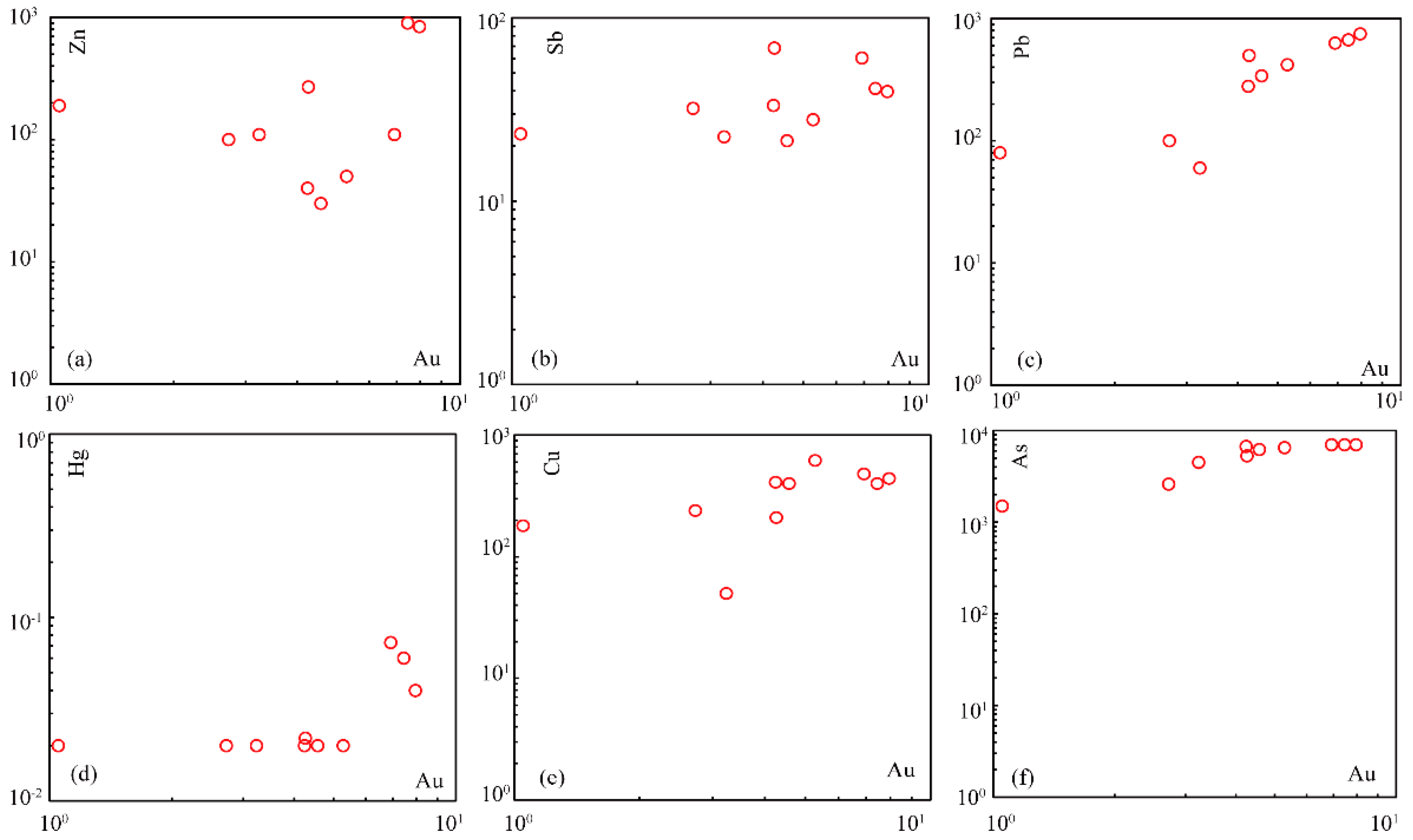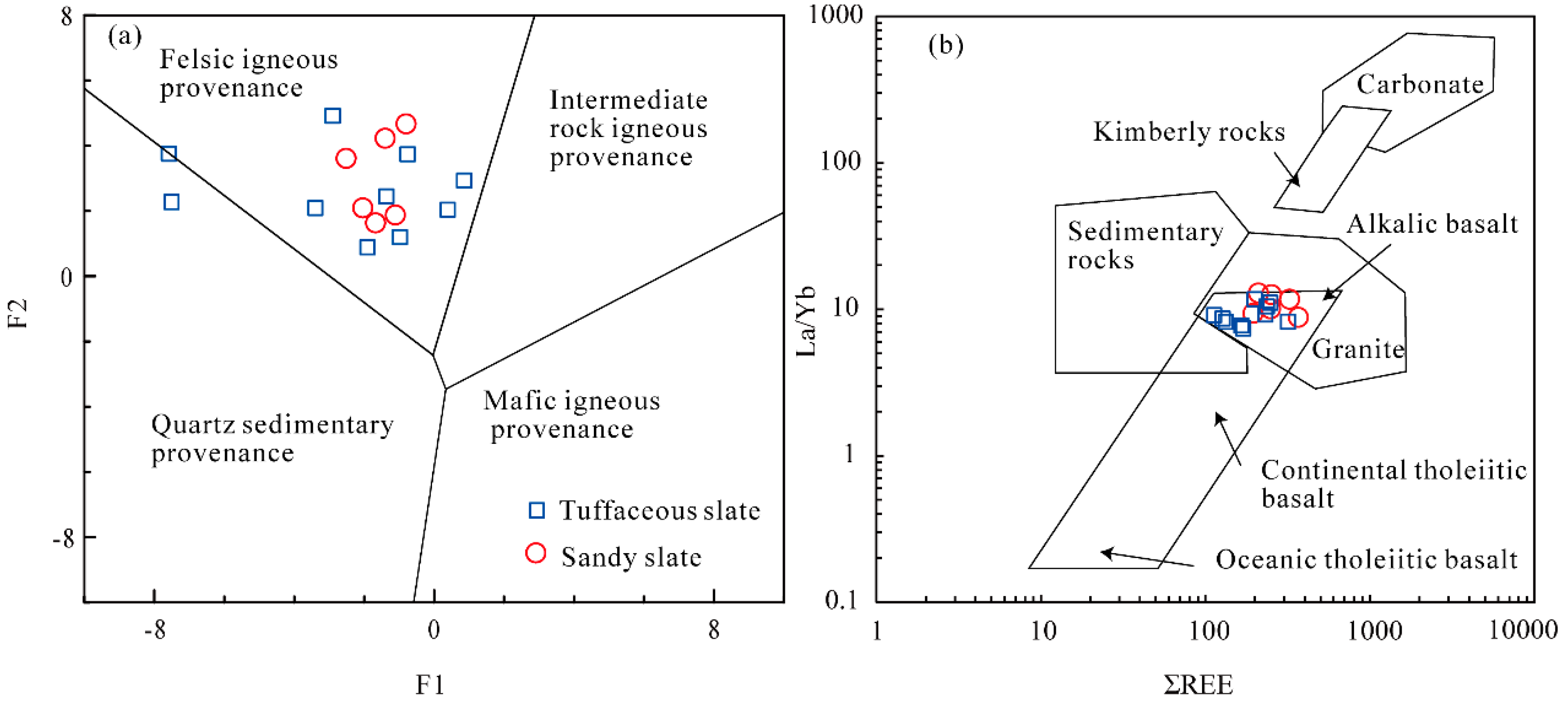Source of the Chaoyangzhai Gold Deposit, Southeast Guizhou: Constraints from LA-ICP-MS Zircon U–Pb Dating, Whole-rock Geochemistry and In Situ Sulfur Isotopes
Abstract
1. Introduction
2. Geological Setting
2.1. Regional Geology
2.2. Ore Deposit Geology
3. Sampling and Analytical Methods
3.1. In Situ LA-ICP-MS Zircon U–Pb Dating
3.2. Whole Rock Major and Trace Elements Analyses
3.3. In Situ LA-MC-ICP-MS Sulfur Isotopic Analyses
4. Results
4.1. LA-ICP-MS Zircon U–Pb Ages
4.2. Major and Trace Element Compositions
4.3. In Situ Sulfur Isotope Compositions
5. Discussion
5.1. Age and Source of Rocks from Qingshuijiang Formation
5.2. Source of the Sulfur and Gold
5.3. Genesis and Age of Turbidite-hosted Gold Deposits in Southeast Guizhou
6. Conclusions
Supplementary Materials
Author Contributions
Funding
Conflicts of Interest
References
- Horne, R.; Culshaw, N. Flexural-slip folding in the Meguma Group, Nova Scotia, Canada. J. Struct. Geol. 2001, 23, 1631–1652. [Google Scholar] [CrossRef]
- Ramsay, W.; Bierlein, F.P.; Arne, D.C.; VandenBerg, A. Turbidite-hosted gold deposits of Central Victoria, Australia: their regional setting, mineralising styles, and some genetic constraints. Ore Geol. Rev. 1998, 13, 131–151. [Google Scholar] [CrossRef]
- Windh, J. Saddle reef and related gold mineralization, Hill End gold field, Australia: Evolution of an auriferous vein system during progressive deformation. Econ. Geol. 1995, 90, 1764–1775. [Google Scholar] [CrossRef]
- Lu, H.Z.; Wang, Z.G.; Chen, W.Y.; Wu, X.Y.; Zhu, X.Q.; Hu, R.Z. Turbidite hosted gold deposits in southeast Guizhou: Their structural control, mineralization characteristics, and some genetic constrains. Miner. Depos. 2006, 4, 369–387. (In Chinese) [Google Scholar]
- Arne, D.C.; Bierlein, F.P.; Morgan, J.W.; Stein, H.J. Re–Os dating of sulfides associated with gold mineralization in Central Victoria, Australia. Econ. Geol. 2001, 96, 1455–1459. [Google Scholar] [CrossRef]
- Molnar, F.; Middleton, A.; Stein, H.; O’Brien, H.; Lahaye, Y.; Huhma, H.; Pakkanen, L.; Johanson, B. Repeated syn- and post-orogenic gold mineralization events between 1.92 and 1.76 Ga along the Kiistala Shear Zone in the Central Lapland Greenstone Belt, northern Finland. Ore Geol. Rev. 2018, 101, 936–959. [Google Scholar] [CrossRef]
- Wang, J.; Wen, H.; Li, C.; Zhang, J.; Ding, W. Age and metal source of orogenic gold deposits in Southeast Guizhou Province, China: Constraints from Re–Os and He–Ar isotopic evidence. Geosci. Front. 2019, 10, 581–593. [Google Scholar] [CrossRef]
- Liu, A.; Jiang, M.; Ulrich, T.; Zhang, J.; Zhang, X. Ore genesis of the Bake gold deposit, southeastern Guizhou province, China: Constraints from mineralogy, in-situ trace element and sulfur isotope analysis of pyrite. Ore Geol. Rev. 2018, 102, 740–756. [Google Scholar] [CrossRef]
- Liu, A.; Zhang, X.; Ulrich, T.; Zhang, J.; Jiang, M.; Liu, W. Geology, geochronology and fluid characteristics of the Pingqiu gold deposit, Southeastern Guizhou Province, China. Ore Geol. Rev. 2017, 89, 187–205. [Google Scholar] [CrossRef]
- Xu, D.; Deng, T.; Chi, G.; Wang, Z.; Zou, F.; Zhang, J.; Zou, S. Gold mineralization in the Jiangnan Orogenic Belt of South China: Geological, geochemical and geochronological characteristics, ore deposit-type and geodynamic setting. Ore Geol. Rev. 2017, 88, 565–618. [Google Scholar] [CrossRef]
- Goldfarb, R.J.; Groves, D.I. Orogenic gold: Common or evolving fluid and metal sources through time. Lithos 2015, 233, 2–26. [Google Scholar] [CrossRef]
- Pitcairn, I.K.; Craw, D.; Teagle, D.A.H. Metabasalts as sources of metals in orogenic gold deposits. Miner. Deposita 2015, 50, 373–390. [Google Scholar] [CrossRef]
- Phillips, G.N.; Powell, R. Origin of Witwatersrand gold: A metamorphic devolatilisation-hydrothermal replacement model. Appl. Earth Sci. 2011, 120, 112–129. [Google Scholar] [CrossRef]
- Phillips, G.N.; Powell, R. Formation of gold deposits: a metamorphic devolatilization model. J Metamorph. Geol. 2010, 28, 689–718. [Google Scholar] [CrossRef]
- Pang, J.T.; Dai, T.G. On the mineralization epoch of the Xuefeng gold metallogenic province. Geol. Prospect. 1998, 34, 37–41. (In Chinese) [Google Scholar]
- Li, N.; Pirajno, F. Early Mesozoic Mo mineralization in the Qinling Orogen: An overview. Ore Geol. Rev. 2017, 81, 431–450. [Google Scholar] [CrossRef]
- Tao, P.; Xiao, X.D.; Hu, C.L. The Au-bearing sedimentary sequences and theirimpact on the gold deposits in light metamorphic rock in the boundary of Hunan, Guizhou and Guangxi regions. Geol. Sci. Technol. Inf. 2009, 28, 100–104. (In Chinese) [Google Scholar]
- Sun, J.; Shu, L.; Santosh, M.; Wang, L. Neoproterozoic tectonic evolution of the Jiuling terrane in the central Jiangnan orogenic belt (South China): Constraints from magmatic suites. Precambrian Res. 2017, 302, 279–297. [Google Scholar] [CrossRef]
- Pan, X.; Hou, Z.; Zhao, M.; Chen, G.; Rao, J.; Li, Y.; Wei, J.; Ouyang, Y. Geochronology and geochemistry of the granites from the Zhuxi W–Cu ore deposit in South China: Implication for petrogenesis, geodynamical setting and mineralization. Lithos 2018, 304, 155–179. [Google Scholar] [CrossRef]
- Wang, C.; Rao, J.; Chen, J.; Ouyang, Y.; Qi, S.; Li, Q. Prospectivity mapping for “Zhuxi-type” copper-tungsten polymetallic deposits in the Jingdezhen region of Jiangxi Province, South China. Ore Geol. Rev. 2017, 89, 1–14. [Google Scholar] [CrossRef]
- Mao, J.; Xiong, B.; Liu, J.; Pirajno, F.; Cheng, Y.; Ye, H.; Song, S.; Dai, P. Molybdenite Re/Os dating, zircon U–Pb age and geochemistry of granitoids in the Yangchuling porphyry W–Mo deposit (Jiangnan tungsten ore belt), China: Implications for petrogenesis, mineralization and geodynamic setting. Lithos 2017, 286, 35–52. [Google Scholar] [CrossRef]
- Huang, L.; Jiang, S. Highly fractionated S-type granites from the giant Dahutang tungsten deposit in Jiangnan Orogen, Southeast China: Geochronology, petrogenesis and their relationship with W-mineralization. Lithos 2014, 202, 207–226. [Google Scholar] [CrossRef]
- Wang, J.; Wen, H.; Li, C.; Jiang, X.; Zhu, C.; Du, S.; Zhang, L. Determination of age and source constraints for the Bake quartz vein-type gold deposit in SE Guizhou using arsenopyrite Re–Os chronology and REE characteristics. Geochem. J. 2015, 49, 73–81. [Google Scholar] [CrossRef]
- Deng, J.; Wang, Q. Gold mineralization in China: Metallogenic provinces, deposit types and tectonic framework. Gondwana Res. 2016, 36, 219–274. [Google Scholar] [CrossRef]
- Lu, H.Z.; Wang, Z.G.; Wu, X.Y.; Chen, W.Y.; Zhu, X.Q.; Guo, D.J.; Hu, R.Z.; Keita, M. Turbidite-hosted gold Deposits in SE Guizhou Province, China: Their regional setting, structural control and gold mineralization. Acta Geol. Sin. 2005, 79, 98–105. [Google Scholar]
- Tao, P.; Chen, Q.F.; Wang, L.; Hu, C.L. Location prediction of gold deposits for ore field grade in the Tianzhu-Jinping-Liping area, southeastern Guizhou, China: The method on potential assessment of mineral resources of low-exploration and study degree area. J. Jilin Univ. 2013, 4, 1235–1245. (In Chinese) [Google Scholar]
- Goldfarb, R.J.; Taylor, R.D.; Collins, G.S.; Goryachev, N.A.; Orlandini, O.F. Phanerozoic continental growth and gold metallogeny of Asia. Gondwana Res. 2014, 25, 48–102. [Google Scholar] [CrossRef]
- Zhou, T.H.; Goldfarb, R.J.; Phillips, G.N. Tectonics and distribution of gold deposits in China—an overview. Miner. Deposita 2002, 37, 249–282. [Google Scholar] [CrossRef]
- Ren, J.S. The continental tectonics of China. J. SE Asian Earth Sci. 1996, 13, 197–204. [Google Scholar] [CrossRef]
- Zeng, G.; Gong, Y.; Wang, Z.; Hu, X.; Xiong, S. Structures of the Zhazixi Sb–W deposit, South China: Implications for ore genesis and mineral exploration. J. Geochem. Explor. 2017, 182, 10–21. [Google Scholar] [CrossRef]
- Liu, L.; Li, S.; Dai, L.; Suo, Y.; Liu, B.; Zhang, G.; Wang, Y.; Liu, E. Geometry and timing of Mesozoic deformation in the western part of the Xuefeng Tectonic Belt, South China: Implications for intra-continental deformation. J. Asian Earth Sci. 2012, 49, 330–338. [Google Scholar] [CrossRef]
- Wiedenbeck, M.; Alle, P.; Corfu, F.; Griffin, W.L.; Meier, M.; Ober, F.; Von Quadt, A.; Roddick, J.C.; Speigel, W. Three natural zircon standards for U–Th–Pb, Lu–Hf, trace-element and REE analyses. Geostand. Geoanal. Res. 1995, 19, 1–23. [Google Scholar] [CrossRef]
- Elhlou, S.; Belousova, E.; Griffin, W.L.; Pearson, N.J.; O Reilly, S.Y. Trace element and isotopic composition of GJ-red zircon standard by laser ablation. Geochim. Cosmochim. Ac. 2006, 70, A158. [Google Scholar] [CrossRef]
- Liu, Y.; Gao, S.; Hu, Z.; Gao, C.; Zong, K.; Wang, D. Continental and Oceanic Crust Recycling-induced Melt-Peridotite Interactions in the Trans-North China Orogen: U–Pb Dating, Hf Isotopes and Trace Elements in Zircons from Mantle Xenoliths. J. Petrol. 2010, 51, 537–571. [Google Scholar] [CrossRef]
- Liu, Y.; Hu, Z.; Gao, S.; Guenther, D.; Xu, J.; Gao, C.; Chen, H. In situ analysis of major and trace elements of anhydrous minerals by LA-ICP-MS without applying an internal standard. Chem. Geol. 2008, 257, 34–43. [Google Scholar] [CrossRef]
- Andersen, T. Correction of common lead in U–Pb analyses that do not report 204Pb. Chem. Geol. 2002, 192, 59–79. [Google Scholar] [CrossRef]
- Sláma, J.; Košler, J.; Condon, D.J.; Crowley, J.L.; Gerdes, A.; Hanchar, J.M.; Horstwood, M.S.A.; Morris, G.A.; Nasdala, L.; Norberg, N.; et al. Plešovice zircon—A new natural reference material for U–Pb and Hf isotopic microanalysis. Chem. Geol. 2008, 249, 1–35. [Google Scholar] [CrossRef]
- Bao, Z.; Chen, L.; Zong, C.; Yuan, H.; Chen, K.; Dai, M. Development of pressed sulfide powder tablets for in situ sulfur and lead isotope measurement using LA-MC-ICP-MS. Int. J. MASS Spectrom. 2017, 421, 255–262. [Google Scholar] [CrossRef]
- Yuan, H.; Liu, X.; Chen, L.; Bao, Z.; Chen, K.; Zong, C.; Li, X.; Qiu, J.W. Simultaneous measurement of sulfur and lead isotopes in sulfides using nanosecond laser ablation coupled with two multi-collector inductively coupled plasma mass spectrometers. J. Asian Earth Sci. 2018, 154, 386–396. [Google Scholar] [CrossRef]
- Chen, L.; Chen, K.; Bao, Z.; Liang, P.; Sun, T.; Yuan, H. Preparation of standards for in situ sulfur isotope measurement in sulfides using femtosecond laser ablation MC-ICP-MS. J. Anal. Atom Spectrom. 2017, 32, 107–116. [Google Scholar] [CrossRef]
- Hoskin, P.W.O.; Schaltegger, U. The composition of zircon and igneous and metamorphic petrogenesis. Rev. Mineral. Geochem. 2003, 53, 27–62. [Google Scholar] [CrossRef]
- Sun, S.S.; McDonough, W.F. Chemical and isotopic systematics of oceanic basalts: Implications for mantle compositions and processes. In Magmatism in the Ocean Basins; Saunders, A.D., Norry, M.J., Eds.; Geological Society of London Special Paper: London, UK, 1989; Volume 32, pp. 313–345. [Google Scholar]
- Taylor, S.R.; McLennan, S.M. Continental Crust: Its Composition and Evolution. An Examination of the Geochemical Record Preserved in Sedimentary Rocks; Blackwell Science Inc.: Boston, MA, USA, 1985; p. 312. [Google Scholar]
- Wei, Y.N.; Jiang, X.S.; Cui, X.Z.; Zhuo, J.W.; Jiang, Z.F.; Cai, J.J. Deterital zircon U–Pb ages of the Neoproterzoic Qingshuijiang Formation in Southeastern Guizhou and their geological significance. J. Miner. Petrol. 2015, 35, 61–71. [Google Scholar]
- Wang, X.; Li, X.; Li, Z.; Li, Q.; Tang, G.; Gao, Y.; Zhang, Q.; Liu, Y. Episodic Precambrian crust growth: Evidence from U–Pb ages and Hf–O isotopes of zircon in the Nanhua Basin, central South China. Precambrian Res. 2012, 222, 386–403. [Google Scholar] [CrossRef]
- Wang, L.; Griffin, W.L.; Yu, J.; O Reilly, S.Y. Precambrian crustal evolution of the Yangtze Block tracked by detrital zircons from Neoproterozoic sedimentary rocks. Precambrian Res. 2010, 177, 131–144. [Google Scholar] [CrossRef]
- Wang, J.; Shu, L.; Santosh, M. U–Pb and Lu–Hf isotopes of detrital zircon grains from Neoproterozoic sedimentary rocks in the central Jiangnan Orogen, South China: Implications for Precambrian crustal evolution. Precambrian Res. 2017, 294, 175–188. [Google Scholar] [CrossRef]
- Ma, X.; Yang, K.; Li, X.; Dai, C.; Zhang, H.; Zhou, Q. Neoproterozoic Jiangnan Orogeny in southeast Guizhou, South China: Evidence from U–Pb ages for detrital zircons from the Sibao Group and Xiajiang Group. Can. J. Earth Sci. 2016, 53, 219–230. [Google Scholar] [CrossRef]
- Roser, B.P.; Korsch, R.J. Provenance signatures of sandstone mudstone suites determined using discriminant function-analysis of major-element data. Chem. Geol. 1988, 67, 119–139. [Google Scholar] [CrossRef]
- Allegre, C.J.; Minster, J.F. Quantitative models of trace-element behavior in magmatic processes. Earth Planet. Sc. Lett. 1978, 38, 1–25. [Google Scholar] [CrossRef]
- Anani, C.Y.; Bonsu, S.; Kwayisi, D.; Asiedu, D.K. Geochemistry and provenance of Neoproterozoic metasedimentary rocks from the Togo structural unit, Southeastern Ghana. J. Afr. Earth Sci. 2019, 153, 208–218. [Google Scholar] [CrossRef]
- Lu, Y.; Zhu, W.; Ge, R.; Zheng, B.; He, J.; Diao, Z. Neoproterozoic active continental margin in the northwestern Tarim Craton: Clues from Neoproterozoic (meta) sedimentary rocks in the Wushi area, northwest China. Precambrian Res. 2017, 298, 88–106. [Google Scholar] [CrossRef]
- Bauer, M.E.; Burisch, M.; Ostendorf, J.; Krause, J.; Frenzel, M.; Seifert, T.; Gutzmer, J. Trace element geochemistry of sphalerite in contrasting hydrothermal fluid systems of the Freiberg district, Germany: Insights from LA-ICP-MS analysis, near-infrared light microthermometry of sphalerite-hosted fluid inclusions, and sulfur isotope geochemistry. Miner. Deposita 2019, 54, 237–262. [Google Scholar]
- Hu, X.; Tang, L.; Zhang, S.; Santosh, M.; Spencer, C.J.; Zhao, Y.; Cao, H.; Pei, Q. In situ trace element and sulfur isotope of pyrite constrain ore genesis in the Shapoling molybdenum deposit, East Qinling Orogen, China. Ore Geol. Rev. 2019, 105, 123–136. [Google Scholar] [CrossRef]
- Li, X.; Zhao, K.; Jiang, S.; Palmer, M.R. In-situ U–Pb geochronology and sulfur isotopes constrain the metallogenesis of the giant Neves Corvo deposit, Iberian Pyrite Belt. Ore Geol. Rev. 2019, 105, 223–235. [Google Scholar] [CrossRef]
- Liang, J.; Li, J.; Sun, W.; Zhao, J.; Zhai, W.; Huang, Y.; Song, M.; Ni, S.; Xiang, Q.; Zhang, J.; et al. Source of ore-forming fluids of the Yangshan gold field, western Qinling orogen, China: Evidence from microthermometry, noble gas isotopes and in situ sulfur isotopes of Au-carrying pyrite. Ore Geol. Rev. 2019, 105, 404–422. [Google Scholar] [CrossRef]
- Downes, P.M.; Seccombe, P.K.; Carr, G.R. Sulfur- and lead-isotope signatures of orogenic gold mineralisation associated with the Hill End Trough, Lachlan Orogen, New South Wales, Australia. Miner. Petrol. 2008, 94, 151–173. [Google Scholar] [CrossRef]
- Jia, Y.F.; Li, X.; Kerrich, R. Stable isotope (O, H, S, C, and N) systematics of quartz vein systems in the turbidite-hosted Central and North Deborah gold deposits of the Bendigo cold field, Central Victoria, Australia: Constraints on the origin of ore-forming fluids. Econ. Geol. 2001, 96, 705–721. [Google Scholar] [CrossRef]
- Hoefs, J. Stable Isotope Geochemistry; Spring: Berlin/Heidelberg, Germany, 2009; pp. 71–73. [Google Scholar]
- Zhu, Y.; An, F.; Tan, J. Geochemistry of hydrothermal gold deposits: A review. Geosci. Front. 2011, 2, 367–374. [Google Scholar] [CrossRef]
- Zhang, J.; Yu, D.L.; Zhang, X.Y.; Yang, Y.J. Geochemical characteristice and modes of occurrence of gold in the Moshan-Youmaao gold deposit of Tianzhu, Guizhou. J. Guizhou Univ. Technol. 1997, 26, 43–49. (in Chinese). [Google Scholar]
- Zhang, H.; Zhu, Y. Mechanism of gold precipitation in the Gezigou gold deposit, Xinjiang, NW China: Evidence from fluid inclusions and thermodynamic modeling. J. Geochem. Explor. 2019, 199, 60–74. [Google Scholar] [CrossRef]
- Song, G.X.; Cook, N.J.; Wang, L.; Qin, K.Z.; Ciobany, C.; Li, G.M. Gold behavior in intermediate sulfidation epithermal systems: A case study from the Zhengguang gold deposit, Heilongjiang Province, NE-China. Ore Geol. Rev. 2019, 106, 446–462. [Google Scholar] [CrossRef]
- Kovalev, K.R.; Kalinin, Y.A.; Naumov, E.A.; Kolesnikova, M.K.; Korolyuk, V.N. Gold-bearing arsenopyrite in eastern Kazakhstan gold-sulfide deposits. Russ. Geol. Geophys. 2011, 52, 178–192. [Google Scholar] [CrossRef]
- Cook, N.J.; Ciobanu, C.L.; Meria, D.; Silcock, D.; Wade, B. Arsenopyrite-Pyrite Association in an Orogenic Gold Ore: Tracing Mineralization History from Textures and Trace Elements. Econ. Geol. 2013, 108, 1273–1283. [Google Scholar] [CrossRef]
- Salvi, S.; Velasquez, G.; Miller, J.M.; Beziat, D.; Siebenaller, L.; Bourassa, Y. The Pampe gold deposit (Ghana): Constraints on sulfide evolution during gold mineralization. Ore Geol. Rev. 2016, 78, 673–686. [Google Scholar] [CrossRef]
- Zhao, J.; Liang, J.L.; Li, J.; Ni, X.S.; Xiang, Q.R. Genesis and metallogenic model of the Shuiyindong gold deposit, Guizhou Province: Evidences from high-resolution multi-element mapping and in situ sulfur isotopes of Au-carrying pyrites by NanoSIMS. Earth Sci. Fron. 2018, 25, 157–167. (in Chinese). [Google Scholar]
- Fan, H.R.; Zhai, M.G.; Xie, Y.H.; Yang, J.H. Ore-forming fluids associated with granite-hosted gold mineralization at the Sanshandao deposit, Jiaodong gold province, China. Miner. Deposita 2003, 38, 739–750. [Google Scholar] [CrossRef]
- Yoo, B.C.; Lee, H.K.; White, N.C. Mineralogical, fluid inclusion, and stable isotope constraints on mechanisms of ore deposition at the Samgwang mine (Republic of Korea)—A mesothermal, vein-hosted gold-silver deposit. Miner. Deposita 2010, 45, 161–187. [Google Scholar] [CrossRef]
- Wu, W.M.; Liu, J.Z.; Wang, Z.P.; Yu, D.L. Indicative significance of H–O isotope and fluid inclusion in ore-forming fluid of Pingqiu gold mine, Guizhou province. Gold Sci. Technol. 2015, 23, 30–36. [Google Scholar]
- Seward, T.M.; Williams-Jones, A.E.; Migdisov, A.A. The chemistry of metal transport and deposition by ore-forming hydrothermal fluids. In Treatise on Geochemistry, 2nd ed.; Turekian, K., Holland, H., Eds.; Elsevier: New York, NY, USA, 2014; Volume 13, pp. 29–57. [Google Scholar]
- Williams-Jones, A.E.; Bowell, R.J.; Migdisov, A.A. Gold in solution. Elements 2009, 5, 281–287. [Google Scholar] [CrossRef]
- Pal’yanova, G. Physicochemical modeling of the coupled behavior of gold and silver in hydrothermal processes: Gold fineness, Au/Ag ratios and their possible implications. Chem. Geol. 2008, 255, 399–413. [Google Scholar] [CrossRef]
- Tian, H.D.; Huang, D.G.; Yu, Q.P. Analyses on gelogic characters and genesis of Kengtou gold deposit in Tianzhu, Southeast Guizhou. Guizhou Geol. 2011, 28, 265–271. (in Chinese). [Google Scholar]
- Peng, J.T.; Hu, R.Z.; Zhao, J.H.; Fu, Y.Z.; Lin, Y.X. Scheelite Sm–Nd dating and quartz Ar–Ar daing of Au–Sb–W depos it in Woxi, west Hunan. Chin. Sci. Bull. 2003, 48, 1976–1981. (in Chinese). [Google Scholar] [CrossRef]
- Wang, X.Z.; Liang, H.Y.; Shan, Q.; Cheng, J.P.; Xia, P. Metallogenic age of the Jinshan gold deposit and Caledonian gold mineralization in South China. Geo. Rev. 1999, 45, 19–25. (in Chinese). [Google Scholar]









© 2019 by the authors. Licensee MDPI, Basel, Switzerland. This article is an open access article distributed under the terms and conditions of the Creative Commons Attribution (CC BY) license (http://creativecommons.org/licenses/by/4.0/).
Share and Cite
Tsang, H.; Cao, J.; Yang, X. Source of the Chaoyangzhai Gold Deposit, Southeast Guizhou: Constraints from LA-ICP-MS Zircon U–Pb Dating, Whole-rock Geochemistry and In Situ Sulfur Isotopes. Minerals 2019, 9, 235. https://doi.org/10.3390/min9040235
Tsang H, Cao J, Yang X. Source of the Chaoyangzhai Gold Deposit, Southeast Guizhou: Constraints from LA-ICP-MS Zircon U–Pb Dating, Whole-rock Geochemistry and In Situ Sulfur Isotopes. Minerals. 2019; 9(4):235. https://doi.org/10.3390/min9040235
Chicago/Turabian StyleTsang, Hinyuen, Jingya Cao, and Xiaoyong Yang. 2019. "Source of the Chaoyangzhai Gold Deposit, Southeast Guizhou: Constraints from LA-ICP-MS Zircon U–Pb Dating, Whole-rock Geochemistry and In Situ Sulfur Isotopes" Minerals 9, no. 4: 235. https://doi.org/10.3390/min9040235
APA StyleTsang, H., Cao, J., & Yang, X. (2019). Source of the Chaoyangzhai Gold Deposit, Southeast Guizhou: Constraints from LA-ICP-MS Zircon U–Pb Dating, Whole-rock Geochemistry and In Situ Sulfur Isotopes. Minerals, 9(4), 235. https://doi.org/10.3390/min9040235






